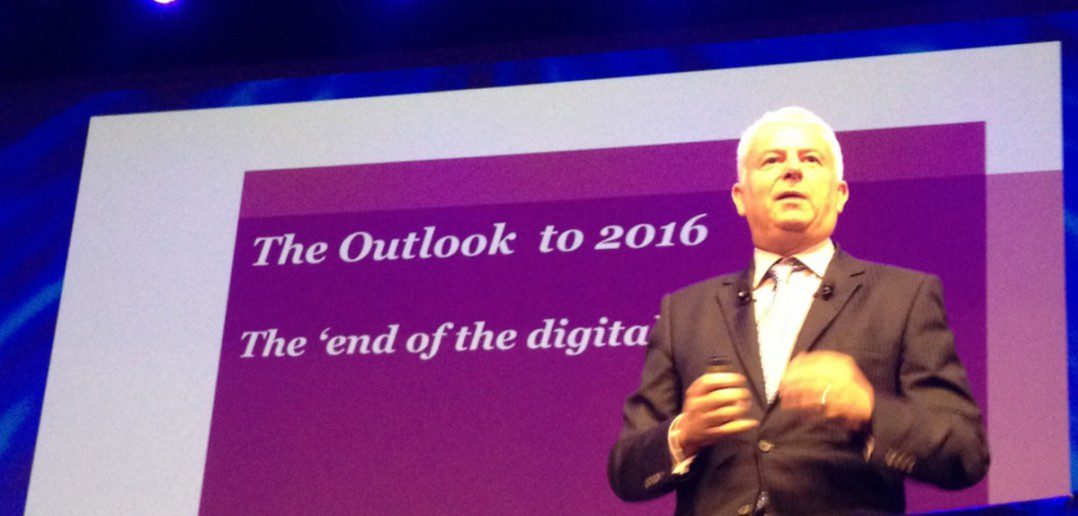Marcel Fenez, the global leader of PwC’s Entertainment & Media department, kicked off his talk with a rather subversive theme: « an acknowledgement that we’re at the end of the digital beginning ».
Entertainment and media growth rates through 2016 are expected to grow 5.7% globally (compound annual growth rate, or CAGR). Of these, the US will be at 5.2%, France at 3.4%, and UK at 3.1%. Canada, our theme country of the month, happens to be doing exceptionally well: 6.5% year over year.
« Where’s the growth coming from? It’s all coming from digital. Or most of it, » said Fenez. « Digital is the new normal. So let’s get used to it. »
Figured on global advertising breakdowns followed, primarily to demonstrate that TV isn’t hurting as much as we imagined it would two years ago. In China, Fenez acknowledged, TV advertising truly is losing share to digital and online… but elsewhere it’s holding its own. « TV’s still growing, » he emphasised, adding, for clarity, that « Search is still what kicks the digital number up by a long way » — meaning that the most basic forms of digital advertising remain the strongest in this domain.
Otherwise, consumer spending on all media is dominated by TV, which is still an important driver of overall consumer global spending growth (3.8% CAGR, of which video games comprise 7% and TV subscriptions comprise 6.8%) between 2011 and 2016.
What’s driving the digital normal? Consumer activity. And it’s changed plenty in two years.
Here were the key messages PwC gleaned from consumers two years ago:
– They don’t care about channels, but love content
– They love the added-value content experience even more
– Content consumption is less about when and where, and more about convenience
– They don’t care about service providers, but love devices
– They don’t care about owning and are happy to stream
– They’re keen to move away from device storage in favour of cloud storage
Here’s what consumers are saying today:
– The multi-screen experience is key. They need to be able to access media they want from any device, and they expect it to work agnostically.
– Recommendations shape choice, all the more reason to pay attention to what people are telling each other about your content
– They’re paying for quality and the experience. Ownership of the content no longer even factors in. « Content is king … but experience is where we’re going to make the money, » Fenez emphasised
– Content must be experienced on « my time » … but also as a shared experience. « It’s my entertainment »: they decide when to watch it and how, but they also decide who they want to engage with, and in what way, while watching. (People who livetweet during political events or TV shows, while using the same hashtag so they can converse with one another, are a good example of this.)
– Connectivity and rights barriers must evolve. From one user: « If I could use a Pay-Per-View service to watch a programme broadcast in another country, I would definitely do that. »
– Targeted advertising – « Make it worth it ». Consumers understand that advertising is necessary, but they want added value from it. Where’s the special offer, where’s the relevance, where’s the added experience that makes the message special to them?
– Love it or hate it, always « on ». Like it or not, consumers are connected constantly. One user said that since receiving her iPhone, she doesn’t believe she’s turned it off once!
« Four or five years ago, » Fenez said, « we talked about the death of prime time in favour of ‘my time’. » But instead of one eating the other, he believes that the entertainment space has instead coalesced into « shared time. »
« The social influencer is alive and well, and is the person that we need to embrace, » he emphasised.
This is just part of The New Normal. A crucial part of embracing this particularly fickle unicorn is to incorporate the following new roles into your value chain, such as Device developer; Community curator; Digital services champion; Content monopoliser; or Idea generator.
These roles will empower you to embed The New Normal into everything you do, thereby making digital key to content production, marketing, distribution and other parts of the value chain.
But the biggest detail you ought to extract from this session is that it doesn’t suffice to say « content is king ». The importance of data in this new world cannot be emphasised sufficiently.
« One of the key things is convincing the consumer to part with their data, but to do so in the context of trust, » Fenez stressed. Users must know what you plan to do with their information. At all times, « the consumer has to be in control. »
Or feel like he is, anyway.




